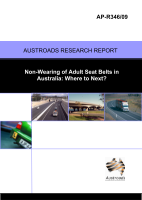Road Safety

- Publication no: AP-R346-09
- ISBN: 978-1-921551-89-5
- Published: 9 December 2009
- PDF (free) Download
Seat belts are one of the most effective passive safety features in vehicles and there is a host of research literature attesting to the effectiveness of seat belts in protecting against death and injury. Even when use rates are high the potential gains in trauma reduction from further improvements in wearing rates are substantial. However, those currently most resistant to restraint use have also proven most difficult to target using conventional countermeasures. It is necessary to address the issues of non-wearing in order to achieve further gains in seat belt wearing.
This study provide evidence-based recommendations for the way forward to tackle the problems of adult restraint non-use in light passenger vehicles in the short, medium and longer term in Australia. While there are substantial issues to be addressed for these groups, these are outside the scope of this study.
- Project Manager
- Prepared by
- 1.1. Aims of the current study
- 1.2. Project tasks and structure of the report
- 1.2.1. Review of the literature
- 1.2.2. Summary of international and Australian practices and initiatives
- 1.2.3. Summary analysis of jurisdictional data
- 1.2.4. In-depth analysis of Western Australian linked data
- 1.2.5. Provision of recommendations and conclusions
- 2.1. Seat belt effectiveness
- 2.2. Seat belt non-wearers
- 2.2.1. Demographic and Situational Factors
- 2.2.2. Individual Differences and Behavioural Factors
- 2.2.3. Methodological shortcomings
- 2.2.4. Summary and Conclusion
- 2.3. Measures to increase seat belt wearing rates
- 2.3.1. Seat belt legislation
- 2.3.2. Seat belt enforcement
- 2.3.3. Publicity and Education
- 2.3.4. Technological solutions: Seat belt reminder systems
- 2.4. Summary
- 3.1. International initiatives
- 3.2. National initiatives
- 3.3. Jurisdictional Initiatives
- 3.3.1. Summary of jurisdictional policies and practices
- 4.1. Aims and Method
- 4.2. Results
- 5.2.1. Analysis of seat belt use by Indigenous status, place of residence, and place of birth
- 5.2.1. .1 Indigenous Status
- 5.2.1. .2 Place of Residence
- 5.2.1. .3 Place of Birth
- 5.2.2. Factors associated with the non-use of a seat belt by injured occupants with a linked Police, death, and hospital admission record
- 5.2.2. .1 Univariate Logistic Regression of Seat Belt Non-Use
- 5.2.2. .2 Multivariate Logistic Regression of Seat Belt Non-Use.
- 5.2.3. Analysis of missing information on seat belt use
- 4.3. Summary and Conclusions
- 5.1. Method
- 5.1.1. Linkage of Western Australian hospital admission and death records with Police recorded crash records
- 5.1.1. .1 Hospitalisation and Death Records
- 5.1.1. .2 Road Crash Linkage
- 5.1.1. .3 Description of Linked Records
- 5.2. Results
- 5.3. Summary of Western Australian Linked Data Analyses
- 6. CONCLUSIONS AND RECOMMENDATIONS
- 7. REFERENCES
- INFORMATION RETRIEVAL
